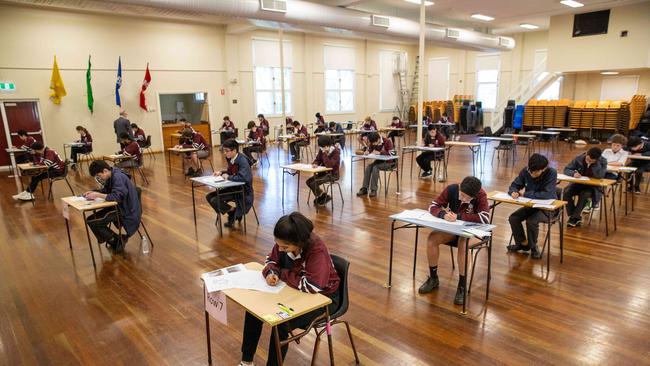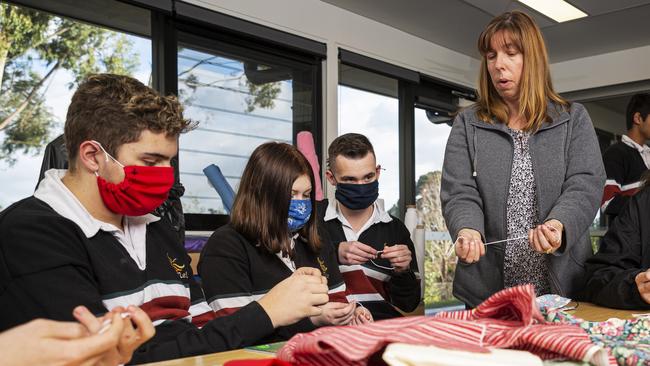Coronavirus and education: Lessons from the pandemic
A rethink of schooling has become more urgent in the wake of COVID-19.

There has long been a push for school education to break free from its so-called industrial-era shackles: the factory-like classrooms, rigid timetables and checklist of facts and figures imparted to young people as they prepare for the world of work.
Earlier this year, under the spectre of a deadly pandemic, it finally happened. Kitchen tables across the nation were transformed into virtual study hubs as fruit bowls were moved aside to make way for laptops, textbooks and pencil cases. Fast-speed internet broadband became the must-have household accessory as small children, some barely out of nappies, spent their days logging in and out of videoconferencing calls.
As Winston Churchill famously said: Never let a good crisis go to waste. And there has been no shortage of education pundits taking up the challenge.
Chief among them, OECD director of education and skills Andreas Schleicher was quick off the mark back in April, urging education leaders to use the momentum created by the COVID-19 pandemic to “rethink what and how students should learn to prepare for the needs of an interconnected 21st century”.
“You’re going to have a lot of young people who have experienced different forms of learning in this crisis, learning that was more fun, more empowering,” he said. “They will go back to their teachers and say: can we do things differently?”
In Australia, calls for reform have focused largely on standardised testing and assessment, with the National Assessment Program — Literacy and Numeracy, the Australian Tertiary Admission Rank and Higher School Certificate all in the firing line.
Some have suggested that full-time, face-to-face schooling could be a thing of the past and that more freedom could be given to young people to decide what, where and how they wish to learn. Should “passion projects”, which enable students to delve deep into an area of interest, be given greater prominence in the senior years? And what about the assessment of school-leavers? Is there a better way of reflecting the breadth of a student’s achievements across a 13-year period than the current ranking system?
According to Learning First chief executive Ben Jensen, the pandemic has presented a rare gift to those who already have been agitating for changes in education.
“Education is full of discussions about the next revolution and the next great breakthrough in schooling,” he says. “People who do this tend to create a straw man, saying basically all the problems in education are due to not making a particular breakthrough, without ever really saying how that breakthrough will solve the problem. Then COVID-19 came along and it became the reason. Everyone changed their argument to say, ‘We should do what I have always been pushing for but because of the pandemic.’ ”
While there has been widespread admiration for the way schools handled the pivot to remote learning in March — it was the “biggest pedagogical shift in history”, one eductor pointed out — the impact on students’ learning is still largely unknown.

While most states were back at school by mid-year, about one million Victorian students remain at home as the state has been gripped by a second wave of the virus. And with a stage-four lockdown in place until the middle of next month, it remains uncertain whether students will return to school at all this year.
“We don’t have enough evidence yet on the impact on kids’ learning,” Jensen says. “Reports from schools suggest there’s been some slippage, although we don’t know how much. And overseas there’s some research coming out about student wellbeing being impacted and the impact on at-risk kids. The popular debate will be about transformation and revolution, but before we get to that we really need to understand how kids went.”
The topic was the subject of a recent Centre for Independent Studies forum, which posed the question: Do schools need a transformation? The consensus among panellists seemed to be it was still too early to make a definitive call.
“The fact is we don’t know … how all this is going to play out,” Gonski Institute education policy expert Pasi Sahlberg said. “The other thing we don’t know is how well this transition happened. We know there are some children who were not doing that well but also according to some early studies and evidence … there are many children who are doing broadly better not going to school. I think it is too early to say what will be the key lessons.”
Victorian teacher Greg Ashman, a fellow panellist, agreed, pointing out that for many the crisis was ongoing. His Year 12 students were not only learning from home but were also missing out on many of the social rites of passage associated with the final year of schooling. “Self-directed learning tends to be better for students who have the most resources, know the most or are the most advanced in their learning,” he said. “I couldn’t identify a large group of students for whom this has been particularly beneficial.”
Haileybury College in Melbourne’s east is arguably at the forefront of embracing technology, having already established a suite of online and blended courses through its HaileyburyX project. It serves as a prime example of how online learning can expand a student’s learning experience, with Year 8 students recently taking part in a Zoom masterclass with cinematographer Chas Mackinnon, while Adelaide Crows vice-captain Tom Lynch spoke at a recent online assembly about his experience in the AFL.
Principal Derek Scott is excited about the future of education.
“There’s no doubt that everything progressive schools were thinking about doing over a period of three to five years has been brought forward,” he says. “We know that there’s a role for technology to provide greater access for a range of students. As a school we’re working hard to develop micro-credentialed courses, giving students more time to follow projects that are passion-based and giving secondary students a broader range of opportunities.
“We’re considering, in the case of upper secondary students, what is the most beneficial way for them to spend their time. And maybe that means a proportion of time is spent in a virtual classroom from home rather than on campus.”
Scott says he’s confident of providing a strong learning program for students regardless of the medium but doesn’t want to lose sight of the fact school isn’t only about academics. “We do need to think hard about how do you balance the academic with the human social outcomes,” he says.
University of Western Australia education policy lecturer Glenn Savage says the pandemic has thrown the spotlight on the benefit of schools as public institutions. He says their critical role in the socialisation of young people will be a theme of ongoing discussion.
“Some people talk about not needing a traditional classroom any more. I think that’s rubbish,” he says. “If anything, COVID has taught us that schools provide much more than a young person’s learning program … they’re where future citizens are.”
Beyond grades
It has been a challenging year for senior students, particularly those in Year 12. While in England controversy rages over the handling of A-level results after exams were scrapped, the Australian government is adamant that Year 12 students will have an opportunity to sit exams and receive an ATAR that can be used to apply for a university course.
The relevance of the ATAR long has been the subject of debate. While schools, students and their families continue to place significant importance on the ATAR, the higher education sector gradually has been moving away from it as a sole basis for undergraduate admission to a course.
Several universities, including the Australian National University, plan to overlook Year 12 results, instead considering Year 11 results when they consider applications for next year, given the disruption to the final year of study for many students due to the pandemic.
The release of the Looking to the Future report by Peter Shergold in June has served to accelerate the debate about whether the ATAR should be reformed or replaced. According to the report, which was commissioned by the COAG Education Council, “the heavy focus on scholastic performance is seen by students to pay too little regard to the other skills and attributes that they require for successful adulthood”.
“The general characteristics of students need to be given greater weight in the final years at school,” it says. “The ATAR should be regarded as just one important measure of success. We need to educate for and assess the diverse learnings that make the whole person. We need to open doors, not narrow pathways.”
South Australia has been considering for some time how to transform the South Australian Certificate of Education into something that could tell “a more holistic story about the capabilities of the 21st-century student”.
Last year, SACE Board chief executive Martin Westwell flagged the concept of a student “learner profile” that would extend beyond the traditional reporting of grades to demonstrate to universities and future employers “this is who I am as a learner and a person”.
Endorsed by the Shergold report, a “learner profile” would act as a CV, outlining a student’s learning and experiences gained inside and outside of school.
“Students will be guided to recognise the attributes they have acquired through study in the classroom as well as from work experience, volunteering and personal achievement,” it says.
The recommendation, which has yet to be endorsed by Education Council, has spurred a mixed response, with critics suggesting such a move would benefit already advantaged students.
As Ashman told the CIS event earlier this month: “Exams were invented by the ancient Chinese as a means for getting rid of patronage on entry to the civil service. And they still have some value.
“Compare the kid from a single-parent family who gets two buses to school and works on the weekend with the north shore kid who is involved in the local church.
“The north shore kid is going to find it much easier to show evidence of community service and extra-curricular activities and things like that. We can criticise the failings of the system as it stands (but) we have to make sure that what we’re proposing as an alternative is better.”
Jensen agrees. He says those advocating for the ATAR to be scrapped are effectively pushing Australia towards a US-style system, where top college entry hurdles preference advantaged kids who have opportunities to captain the school rowing team, take up unpaid internships at prestigious firms or find time for volunteering.
While universities will likely continue to bypass the ATAR, Jensen warns that there are real impacts for the secondary school curriculum. Schools, particularly well-resourced private schools, will inevitably look to give greater prominence to extra-curricular activities at the expense of the curriculum, he warns.
“And not only the academic components but also the sciences, the arts,” he says. “And this will decrease opportunities for children to develop the critical and creative thinking that opponents of ATAR claim they are trying to support.
“There is no evidence that shifting focus leads to better outcomes for students. We should at the very least be seeing some evidence that the new way is better before we make a massive shift.”
